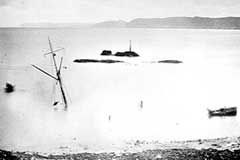Rum was cleared of its indigenous population in the 1820s, who were packed off to Canada. None now remain. Private owners have kept the island as their playground, taking them shooting and fishing. At the end of the 19th century, the Bullough family, textile tycoons from Accrington in Lancashire (England) decided to build a castle there. Kinloch Castle remains as it was at the start of the 20th century, with mind-boggling opulence in an area of Scotland more noted for its grinding poverty at the time. A Steinway grand-piano (which I played twice), 8 ft high Japanese vases, a billiard room. At one time, conservatories lined the exterior of the castle, fully heated. Humming birds flitted around these, until the central heating broke. Their remains are now pinned up in a glass case. Kinloch Castle was occupied by its owner for 6 weeks out of every 52 in the year. Its demise began with the First World War, when the staff were called up. By 1957, the last owner, Lady Monica, had been taken across the island to be laid to rest in the family mausoleum at Harris (different from the Harris south of Lewis). The Nature Conservancy Council were gifted the island for a nominal amount, and they established a study area for red deer.
Rum is a stunning place, but also very sad. Author John Love wrote a book about its history, called A Landscape without Figures. Permanent population 0. Current population is all workers for SNH (successor to NCC).
This set on Flickr.com shows 128 images of the island, including many from within Kinloch Castle. I told its history in a post on Northern Trip from October 2007, when I last visited. A photo compilation can be viewed here. The orchestrion plays here.
Wednesday, 14 January 2009
Thursday, 1 January 2009
In Remembrance - Iolaire 90 years ago
 At 1.55 am on 1 January 1919, HMY Iolaire sank at the Beasts of Holm. More than 200 sailors, the vast majority from Lewis, drowned. About 75 were rescued. The remains of 60 were never recovered. Rather than their loved ones, many island homes received a visit from a church elder, bringing the worst possible news. Followed, not many days later, by the burials of those who had been found on the shores of Stornoway Harbour, the Braighe and Lochs. The circumstances of the sinking have never been satisfactorily cleared up.
At 1.55 am on 1 January 1919, HMY Iolaire sank at the Beasts of Holm. More than 200 sailors, the vast majority from Lewis, drowned. About 75 were rescued. The remains of 60 were never recovered. Rather than their loved ones, many island homes received a visit from a church elder, bringing the worst possible news. Followed, not many days later, by the burials of those who had been found on the shores of Stornoway Harbour, the Braighe and Lochs. The circumstances of the sinking have never been satisfactorily cleared up.A service of remembrance will be held on the shore overlooking the site where Iolaire went down, 90 years ago today. Although I’m not there myself, my thoughts will most definitely be on those lost in the Iolaire, their families left bereaved. I hope that by the 100th anniversary in 2019, the Royal Navy records on this case will be published to finally bring closure on a sad saga.
Those who wish to know more can visit my own webpage or that of the Stornoway Historical Society. A list of casualties and survivors has been collated on this site.

Subscribe to:
Posts (Atom)